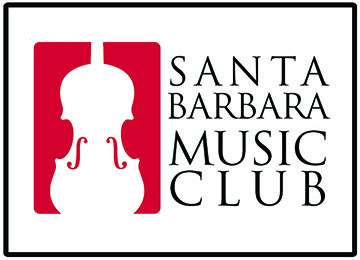
- This event has passed.
Santa Barbara Music Club 50th Season Opening Concert
October 19, 2019 @ 1:00 am PDT

On Saturday, October 19 at 3 p.m. the SANTA BARBARA MUSIC CLUB opens its 2019-2010 season, celebrating 50 years of presenting its stellar series of free concerts of beautiful classical music! Featured at this opening concert are two internationally renowned artists, pianist Betty Oberacker and clarinetist David Singer, performing a program termed “Apotheosis,” meaning a grouping of works that represent the summation of a composer’s musical style. The roster features Oberacker’s performance of two exquisite Preludes and Fugues from Johann Sebastian Bach’s The Well-Tempered Clavier, Book II – in C major, BWV 870, and in F-sharp minor, BWV 882 – followed by Bach’s sparkling Italian Concerto, BWV 971. Singer then joins to conclude the program with the magnificent Sonata in F Minor, Op. 120, No 1, by Johannes Brahms. The concert will be held at the First United Methodist Church, 305 E. Anapamu, Santa Barbara.
The word ‘apotheosis’ has become clichéd, at least in musical discussion, lying just below the most overused words, like ‘genius.’ We tend to ascribe these words to beloved composers, with the works of Johann Sebastian Bach (1685-1750) providing strong examples, as he is generally regard as the apotheosis of the Baroque period. That is quite a broad claim, yet we can glean some truth to this sweeping statement by examining specific works or even characteristics of works against a specialized backdrop.
Take, for example, tonality, which, with its 12 major and 12 minor keys, became the default harmonic practice of Western music between 1600 and 1900. By the 1720s, tonality had been developing for well over a century but barely received systematic, practical grounding in a collection of musical compositions. That all changed when Bach published The Well Tempered Clavier, and, for this reason, the work stands as an apotheosis of Western tonality.
Bach composed 48 preludes and fugues, two in each major and minor key, and spanning two publications: Book I in 1722 and Book II in 1744, with the latter having been influenced by recent improvements in the piano suggested by Bach to his friend, the keyboard instrument builder Gottfried Silbermann. Bach capitalized on the differences each key suggested with regard to character, mood, tuning, and affect. By doing so, Bach codified tonality. This afternoon, Betty Oberacker pairs the most polarizing tonalities of the 24 possible keys, the Preludes and Fugues in C major, BWV 870, and F-sharp minor, BWV 882 from Book II of The Well Tempered Clavier. In music theory, the octave divides into 12 semi-tones. In relation to the pitch C, F# bisects evenly into six semi-tones (the tritone). Therefore, the pitch centers of C and F# lie as far away as one can get in tonality.
While Bach scored the Italian Concerto in F Major, BWV 971, for solo keyboard, the work illustrates his absolute mastery of its form and organization. In addition, it is one of the few works for keyboard that Bach designates for two-manual use (traditionally on the harpsichord). Thus the performer could simulate the concerto style of traversed dynamics – many players vs. few players, tutti vs. concertino, or loud keyboard vs. soft keyboard. Betty Oberacker’s performance on the piano this afternoon substitutes the manual changes of the harpsichord with the dynamic shadings of the piano.
For some, the life of Johannes Brahms (1833-1897) coincided with the rise and fall of so-called High Romanticism in Germany. The clarinet, ironically, never figured largely into his composing. Yet his final two chamber works, sonatas for clarinet and piano, stand not only as masterworks but also as the first of their kind in the genre, and in this sense, the sonatas function as both signpost and summation. On the one hand, they are premier works upon which later composers might build; on the other hand, the pieces came from the pen of a composer who has mastered his craft and has reached the end of his life.
The circumstances surrounding the composition of the Brahms Sonata for Clarinet and Piano in F Minor, Op. 120, No. 1, its companion piece, the Sonata No. 2 in E-flat major, Op. 120, No. 2, and two other major masterworks highlighting the clarinet, are of quite some interest:
In 1891, Brahms had decided to retire from composing altogether. However, after hearing the clarinet music of Mozart and Weber, and after hearing the clarinetist Richard Mühlfeld perform (Brahms was reported by his friends to say that he was “stunned” after hearing Mühlfeld play), he decided to explore the instrument’s potential, resulting in a flurry of phenomenally beautiful chamber pieces for the instrument: the Clarinet Trio in A minor, Op. 114, the Clarinet Quintet in B minor, Op. 115, and the two Sonatas for Clarinet and Piano, Op. 120. Brahms obviously regarded the clarinet as a fitting instrument for the expression of his ideas during his twilight years, as it can sound both opulent and brooding. Betty Oberacker and David Singer close this afternoon’s performance with a work that captures both aspects, as the opening broods with a poignant melancholy – yet finishes with a virtuosity replete with optimistic opulence.
______________________________________________________________________________
The mission of the Santa Barbara Music Club is to contribute to the musical life of our community through the following actions:
● Presentation of an annual series of concerts, free to the public, featuring outstanding solo and chamber music performances by Performing Members and invited guests;
● Presentation of community outreach activities, including bringing great music to residents of area retirement homes;
● Aiding and encouraging musical education by the disbursement of scholarships to talented local music students.
For information on this or other Santa Barbara Music Club programs and performing artists, visit SBMusicClub.org.


